In a year during which much of the country has been plagued by heatwaves, wildfire and drought, there’s a small pocket on the Prairies that’s had its wettest summer in recent memory.
There’s been enough rain in southern Alberta this summer to start making up for the persistent drought that has plagued the Prairies for the better part of the past nine years.
“It’s been like Vancouver here,” said Leroy Newman, a grain farmer near Blackie, Alta., about 15 kilometres east of Okotoks. He said he’s expecting at least a 50 per cent better harvest this year compared to last.
It’s a stunning reversal considering how the season began.
The region experienced drought and warm conditions during the winter and spring, with about two-thirds of the normal mountain snowpack.
Heading into the summer, it looked as though it would be a repeat of the 2023 drought, said John Pomeroy, a professor and director of the Global Water Futures observatories at the University of Saskatchewan.
Then, the rain came.
“[It] saved us,” said Pomeroy, who is based in Canmore, Alta. “If it hadn’t come, we would be in an extremely severe drought situation.”
Southern Alberta experienced “significant” rainfall in July, according to Agriculture and Agri-Food Canada, with many areas getting more than 150 per cent of their normal precipitation. Parts of the southwest got more than 100 millimetres of rainfall, the agency said, and some areas near Calgary had more than 150 millimetres.
Southwestern Saskatchewan has also benefited, with more than 150 per cent of normal precipitation.
Pomeroy noted that some of the weather stations his team monitors in the Rocky Mountains have gotten as much as 500 millimetres of precipitation since May 1, roughly double what would be considered normal.
Plenty of Calgarians have complained this summer about the onslaught of rain. But Graeme Finn, who raises cows near Madden, Alta., has a different take.
‘Springs are starting to flow again’
The dump of water has not only helped this year’s crops, but has also replenished groundwater, dugouts, ponds and reservoirs, setting farmers up with proverbial money in the bank for next year.
“It’s been a godsend,” said Graeme Finn, a beef producer near Madden, Alta., about 60 kilometres northwest of Calgary.
Finn said persistently dry conditions since about 2022 had taken a toll on his business. Dugouts were drying up, forages — the plants that cattle eat — weren’t recovering after spring grazing, and he had begun to sell off some of his older cows.
“Then we got that rain in June and just lit up,” he said. “The springs are starting to flow again.”
Some parts of Prairies still dry
Not everyone has benefited from a boost in moisture. Farmers who seeded crops early are still hurting, as the rain would have come too late to make much of a difference in those regions, said Agriculture and Agri-Food Canada.
In the southeastern part of the province, the federal agency’s drought monitoring map shows there are still areas affected by dry conditions.
There’s also a gulf between the north and south. Whereas southern Alberta has generally benefited from rain, northern and parts of central Alberta have been persistently dry. Several municipalities have declared agricultural disasters.
Elsewhere in Canada, the majority of the country has been parched. As of July 31, 71 per cent of Canada was classified as “abnormally dry” or in “moderate to extreme drought,” according to Agriculture and Agri-Food Canada.
British Columbia, northern Saskatchewan, Manitoba, Ontario and much of Atlantic Canada have all been seeing levels of precipitation below normal levels, said Trevor Hadwen, an agroclimate specialist with the agency.
“Southern Alberta is the anomaly this year,” Hadwen said.

While it’s good news to see a turnaround in the region’s drought situation, Pomeroy, with the University of Saskatchewan, said it’s concerning that Rocky Mountain glaciers — which typically provide drought insurance during dry years in Alberta through their meltwater — continue to shrink, many at a high rate of more than 60 centimetres a week this summer.
The well-known Peyto Glacier, for example, has been melting so quickly that Pomeroy’s team recently had to move a monitoring station from the lower to the upper part of the glacier.
“Without glaciers, we’re dependent on rainfall in the late summer, and rain is very fickle,” said Pomeroy, adding we need better weather prediction systems to keep up with changing conditions.
‘We can make a real profit’
Still, many are finding plenty of reasons to celebrate this month. While the rain may have dampened people’s camping and swimming plans, it’s been a huge boost to farmers.
For now, Newman, the grain farmer, said the rain has likely pushed his harvest out by about two to three weeks. He’s hoping for a bit of sun to finish out the season before the frost comes, but on the whole he’s reflecting on a happy summer.
“It’s been like four or five years since we’ve had a good crop,” he said. “It’s a matter of breaking even all those years to finally getting ahead and having a crop that we can make a real profit on.”







